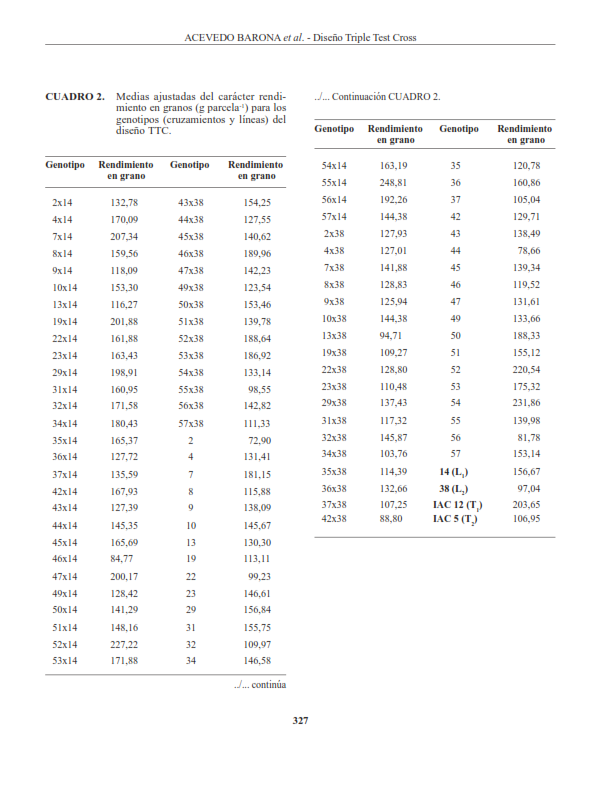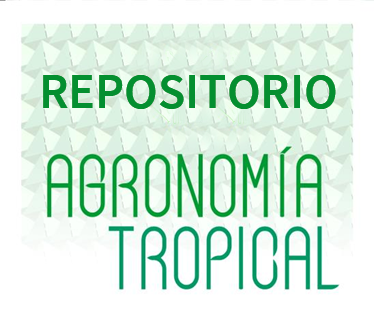Use of the TTC design to detect epistasis in soybean
Abstract
The study of the nature of the genetic variability present in a population is important, not only for the selection of the type of the cultivar but also for the selection of the more appropriate breeding method. In order to study the epistatic variation for grain yield in soybean, the "Modified Triple Test Cross" (TTC) method for plant self (Jinks et al., 1969) was used. The experimental material used in this work was conformed by 32 lines (Pi ), chosen randomly, which later were crossed with the other 2 lines of the same population, contrasting for grain yield and used as testers (L1and L2 ). During cycle 2006/2007, 100 treatments were evaluated in the design triple lattice tripled (9 replicates) in experimental plots of 2.00 meters length, separated 0.50 meters. Considering the methodology of biometric analysis, the contrast of the means (L 1i + L 2i – Pi ) allowed the detection of significant epistasis through F and t-tests for grain yield in soybean. Therefore it is possible to conclude that, in soybean, the character grain yield is affected by the interaction between loci (epistasis).
Downloads
References
• Bernardo, R. 2002. Breeding for quantitative traits in plants. Stemma Press, Woodburg. p. 141.
• Bhatti, M., F. M Azhar, A. W. Albi, and M. Ayub. 2006. Triple test cross analysis of seed cotton (Gossypium hirsutum L.) yield and its components grown in salinized conditions. International Journal of Agriculture and Biology, 8(6):820-823.
• Dickerson, G. 1963. Biological interpretation of genetic parameters of population. In: W. D. Hanson, y H. F. Robinson. Statistical genetic and plant breeding. Washington, D. C: NAS-NCR. Pub. pp 95-107.
• Goldringer, I., P. Brabant and A. Gallais. 1997. Estimation of additive, and epistatic genetic variances for agronomic traits in a population of doubled haploid lines of wheat. Heredity, London, v 79, p. 60-71.
• Hallauer, A. R. and J. B. Miranda Filho.1988. Quantitative genetics in maize breeding. Iowa: State Univ. Press, 468 p.
• Jinks, J. L., J. M. Perkins and E. L. Bresse. 1969. A general method of detecting additive, dominance and epistatic components of variation for metrical traits: II. Application to inbred lines. Heredity, 24, p. 45-57.
• Jinks, J. L. and D. S. Virk. 1977. A modified Triple Test Cross analysis to test and allow for inadequate testers. Heredity, London, 39:165-170.
• Kearsey, M. J. and J. L. Jinks. 1968. A general method of detecting additive, dominance and epistatic variation for metric traits. I. Theory. Heredity. 23:403-409.
• Kearsey, M. J. and H. S. 1996. Pooni, H.S. The genetical analysis of quantitative traits. United Kingdom: Stanley Thones, 381 pp.
• Ketata, H., E. L. Smith, L. H. Edwards and R. W. McNew. 1976. Detection of epistatic, additive and dominance variation in winter wheat (Triticum aestivum L. em Thell). Crop Science, 16:1-4.
• Kusterer, B., J. Muminovic, H. Utz, H. Piepho, S. Barth, M. Heckenberger, R. Meyer, T. Altmann and A. Melchinger. 2007. A. Analysis of a triple testcross design with recombinant inbred lines reveals a significant role of epistasis in heterosis for biomass- related traits in Arabidopsis. Genetics, Pittsburgh, 175(4):2 009-2 017.
• Parvez, A., A. G. Rather and S. Venkatesh, S. 2006. Tri- ple test cross analysis for detection of epistasis for ear characteristics in maize (Zea mays L.). Pakistan Journal of Biological Sciences, 9 (10): 1983-1986.
• Pimentel-Gomes, F. 2000. Curso de Estatística Experi- mental. 14.ed. Piracicaba: ESALQ/USP, 417 p.
• Ramalho, M. A., J. B. Santos e M. J. O. Zimmermann. 1993. Genética quantitativa em plantas autógamas: aplicações ao melhoramento do feijoeiro. Goiânia: UFG, 271p.
• Sallem, M. Y., B. Atta, A. Cheema, Z. Mukhtar and D. Haq. 2005. Detection of epistasis and estimation of additive and dominance components of genetic variation using triple test cross analysis in rice (Oryza sativa L.). Caderno de Pesquisa Série. Biologica. 17 (1):37-50.
• Santos da Silva, V. S. 2005. Seleção de pré-cultivares de soja baseada em índices. Tese (Doutorado), Universidade de São Paulo, Escola Superior de Agri- cultura Luiz de Queiroz, Piracicaba, Brasil. 104 p.
• Silva da Fanuel P. and J. F. Alaves. 1983. Estimation the epistatic, additive and dominance variation in cotton (Gossypium hirsutum L. r. latifolium Hutch). Revista Brasileira de Genética. Brasília. 6(3):491-504.
• Stephens, P. A. C. D. and Nickell.1992. Inheritance of pink flower in soybean. Crop Science, Madison, 32:1 131-1 132.
• Toledo J., F., C. A. Arias, M. Oliveira, C. Triller and Z. Miranda. 2000. Genetical and environmental analyses of yield in six biparental soybean crosses. Pesquisa agropecuaria brasileira, Brasília, 35(9):1 783-1 796.
• Upadhyaya, H. D. and S. N. Nigam. 1999. Detection of epistasis for protein and oil contents and oil quality parameters in peanut. Crop Science. 39:115-118.
• Vega, U. A. 1988. Mejoramiento genético de plantas. Caracas: editorial América. 200 p.
• Vello, N. A. 1992. Ampliação da base genética do germoplasma e melhoramento da soja. In: SIMPÓSIO SOBRE CULTURA E PRODUTI- VIDADE DA SOJA, 1991, Piracicaba. Anais: Piracicaba: FEALQ, p. 60-81.
• Wolf, D. P. and A. R. Hallauer. 1997. Triple testcross analysis to detect epistasis in maize. Crop Science, Madison, 37:763-770.





